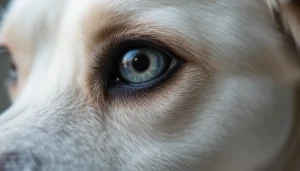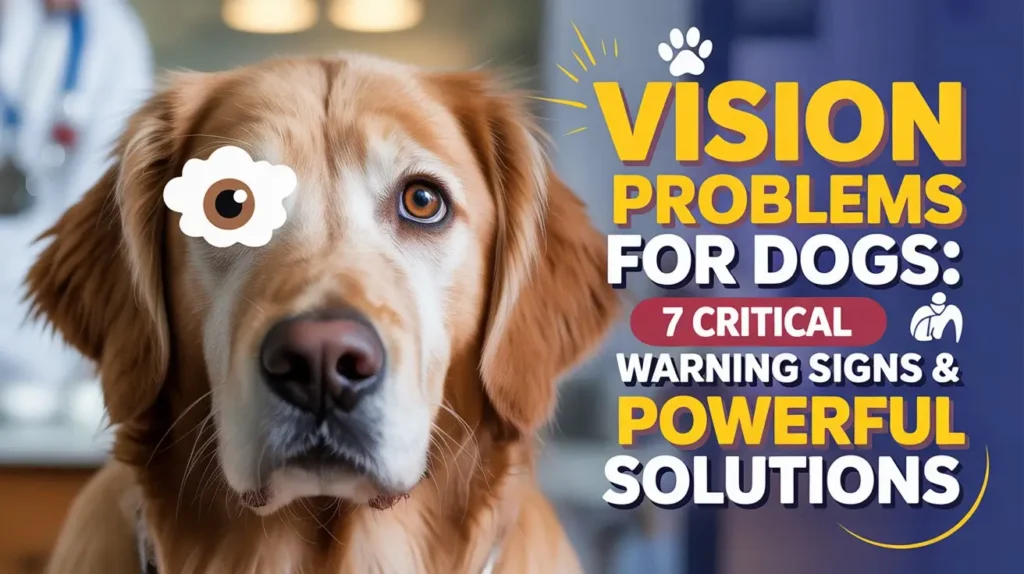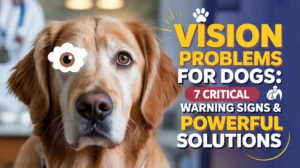Vision Problems for Dogs, ownership of dogs is to ensure that dogs can see at a tender age. All these problems may creep and spoil the life of your pet. You will get to know what to observe, factors that make dogs have vision problems, and the contribution you can make in this guide.
Vision Problems for Dogs -7 warning signs you should not ignore.

Vision Problems for Dogs -7 warning signs you should not ignore.
According to American Kennel Club, “Your dog strikes walls, furniture or places he/she does not know. This usually reflects eye issues among dogs.”
According to PetMD, “The eyes appear opaque, bluish or glazed. The changes are exhibited by many dogs with vision problems.”
According to ACVO Public, “Your dog will be reluctant to walk up the stairs, or to leap down of furniture. That is a faint indication of vision problems among dogs.”
According to Wag, “Your dog is squinting, or has eyes that are red or swollen, or he paws his face. These are possible vision problems of dogs.”
According to American Kennel Club, “Your dog will not touch his favourite toys or refuse to find a bowl with food or water. Dogs can begin to have vision issues which at times begin with minor changes.”
According to American Kennel Club, “Acute alteration of behaviour: nervousness, demandingness or disorientation. The dogs with visual issues in dogs may be less secure.”
According to animaleyeguys.com, “Aging dogs with visual impairment. Dogs develop vision issues that get increasingly more frequently with old age or the presence of a disease.”
Vision Problems for Dogs: What Can Cause Them?

Elderly problems and familial diseases.
According to PetMD, The elderly dogs can experience some alterations in the eyes that makes dogs have problems with their eyesight. As an illustration, hereditary diseases such as progressive retinal atrophy (PRA) gradually lead to impaired sight.
Eye diseases and injuries
According to PetMD, Diseases such as cataracts, glaucoma, cornea ulcers or retinal detachments are some of the causes of many vision problems among the dogs. Even when a dog is not treated immediately after an eye injury, it can cause a problem with the vision.
System diseases and acute disorders.
According to hopecrossing.com, Dogs can also have vision problems due to other body complications- such as diabetes, high blood pressure or hormonal disorders.
According to vetmedbiosci.colostate.edu, Other dogs develop sudden blindness (SARDS syndrome) as a result of a disorder known as SARDS.
Dog Vision problems Diagnosing at an Early Age.
According to PetMD, Your vet will assist in tests and examinations when you are suspecting the dogs to have vision issues. They will examine eye changes, light response, and could adopt special equipment.
According to American Kennel Club, The things that you can do are to observe when your dog started to bump into things, whether your dog bumping into things is new and changes in eating or behavior.
Vision Problems for Dogs: useful tips and solutions.

Immediate-action care
You have realized that there is a problem with the eyesight of the dogs, then make a veterinary appointment. There are instances where eyesight can be rescued because of prompt emergency treatment.
hopecrossing.com
According to PetMD, Take veterinary recommendation of medicines, drops or surgery. Treatment sometimes halts or retards the damage.
Get the home more accommodating to dogs with sight issues.
Otherwise, when one of your pets has dog vision issues, make your house adaptable:
- Store favourites and furniture in the same location.
- Use toys that make sound.
- Lighting: Lighting should be soft and there should be no dark spots.
According to American Kennel Club, Such changes contribute to the feeling of confidence and safety of your dog.
Lifestyle & supportive care
Feed your dog on a good diet and keep him/her busy safely. Ask your vet about vision health supplements. The fact that some of the problems could not be reversed does not mean that good care does not make life better.
- Dog Vision Problems Prevention and Monitoring.
- In order to prevent or minimize vision issues in dogs:
- Have frequent check-ups of the veterinarian including checking of the eyes.
- Look out of the first signs such as cloudiness or changes of behaviour.
- Deal effectively with any chronic health-related problem (e.g., diabetes).
Secure your house and your yard- clear out things your dog might injure himself on.
These actions will assist in identifying the problems with sight on time and ensure that your dog is comfortable.
Concluding the vision issues on dogs.
Vision Problems for Dogs can be terrifying, however, with some understanding and effort you will do so much better. The sooner the better your dog is diagnosed, the greater the chances of him or her living a good life. Be keen, be fast and collaborate with your vet. Your dog counts on you.
Frequently Asked Questions
1. What are the most common vision problems for dogs?
The most common vision problems for dogs include cataracts, glaucoma, corneal ulcers, and progressive retinal atrophy (PRA).
2. How do I know if my dog has vision problems?
If your dog bumps into things, hesitates to move in dim light, or has cloudy eyes, it may have vision problems.
3. Can dogs go blind suddenly?
Yes. Some dogs experience sudden blindness due to conditions like SARDS (Sudden Acquired Retinal Degeneration Syndrome) or eye injuries.
4. Are vision problems for dogs painful?
Some eye issues like glaucoma or infections can cause pain, redness, and squinting. Always consult a vet if your dog shows discomfort.
5. What causes vision loss in dogs?
Vision loss can result from aging, genetics, diabetes, high blood pressure, or untreated eye injuries.
6. Can vision problems for dogs be treated?
Yes, many vision problems for dogs can be treated with medicine, surgery, or lifestyle changes—depending on the cause.
7. How can I help my blind or visually impaired dog?
Keep your home layout consistent, use toys with sound, and provide gentle guidance during walks to keep your dog safe.
8. Are older dogs more likely to have vision problems?
Yes. Senior dogs are more prone to cataracts, glaucoma, and other eye issues due to aging.
9. Can poor diet cause vision problems for dogs?
Yes, lack of nutrients like vitamin A can affect eye health. A balanced diet supports good vision in dogs.
10. How can I prevent vision problems for dogs?
Schedule regular vet checkups, feed healthy food, and treat infections or injuries right away to protect your dog’s eyesight.







